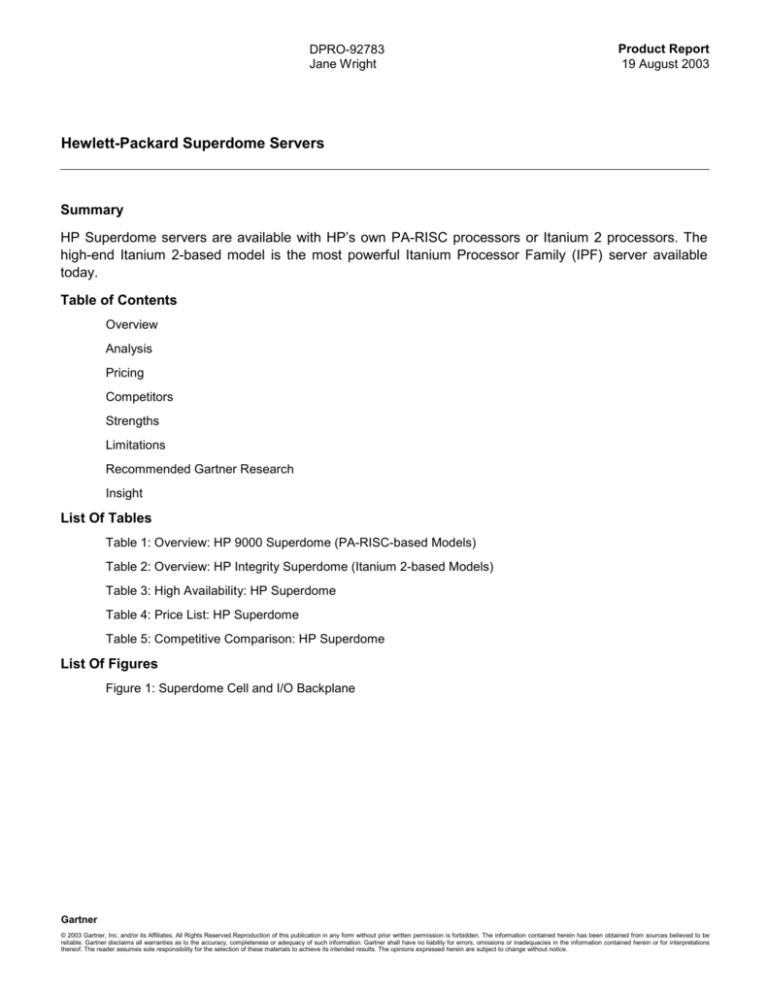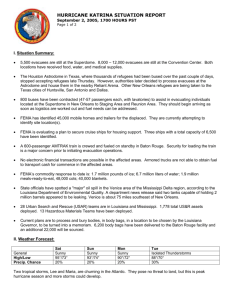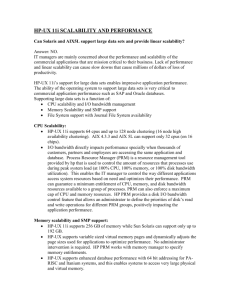
DPRO-92783
Jane Wright
Product Report
19 August 2003
Hewlett-Packard Superdome Servers
Summary
HP Superdome servers are available with HP’s own PA-RISC processors or Itanium 2 processors. The
high-end Itanium 2-based model is the most powerful Itanium Processor Family (IPF) server available
today.
Table of Contents
Overview
Analysis
Pricing
Competitors
Strengths
Limitations
Recommended Gartner Research
Insight
List Of Tables
Table 1: Overview: HP 9000 Superdome (PA-RISC-based Models)
Table 2: Overview: HP Integrity Superdome (Itanium 2-based Models)
Table 3: High Availability: HP Superdome
Table 4: Price List: HP Superdome
Table 5: Competitive Comparison: HP Superdome
List Of Figures
Figure 1: Superdome Cell and I/O Backplane
Gartner
© 2003 Gartner, Inc. and/or its Affiliates. All Rights Reserved.Reproduction of this publication in any form without prior written permission is forbidden. The information contained herein has been obtained from sources believed to be
reliable. Gartner disclaims all warranties as to the accuracy, completeness or adequacy of such information. Gartner shall have no liability for errors, omissions or inadequacies in the information contained herein or for interpretations
thereof. The reader assumes sole responsibility for the selection of these materials to achieve its intended results. The opinions expressed herein are subject to change without notice.
Hewlett-Packard Superdome Servers
Corporate Headquarters
Hewlett-Packard Corp.
3000 Hanover St.
Palo Alto, CA 94304, U.S.A.
Tel: +1 800 533 1333
Fax: +1 800 333 1919
Internet: www.hp.com
Overview
Hewlett-Packard (HP) Superdome servers were introduced in September 2000 as part of the HP 9000
family of 64-bit, RISC-based systems utilizing HP’s Precision Architecture Reduced Instruction Set
Computer (PA-RISC) processors. In June 2003, HP announced new Superdome models supporting
Intel’s Itanium 2 processors. At the same time, HP modified its naming structure: PA-RISC-based models
are called HP 9000 Superdome, and Itanium 2-based models are called HP Integrity Superdome. All
Superdome systems are supported by the HP-UX 11i operating system and the Integrity Superdome
models also support Windows Server Datacenter Edition. Also, the Integrity models are expected to
support Red Hat Linux soon. In fact, HP Integrity Superdome customers will be able to run all three (HPUX, Windows and Linux) operating systems simultaneously on one system. To accomplish this, the
various operating systems must run in separate hardware partitions. HP also plans to support OpenVMS
in a hardware partition on the Integrity Superdome in 2004.
Superdome systems are aimed at enterprises requiring large amounts of processing power. Typical
applications include customer relationship management (CRM), enterprise resource planning (ERP),
electronic commerce and high-performance technical computing. HP envisions some customers
deploying Superdome as a consolidation system, replacing a number of smaller Unix servers.
There are six models in the Superdome family, as shown below:
•
HP 9000 Superdome 16-way, supporting up to 16 PA-RISC 8700 or 8700+ processors
•
HP 9000 Superdome 32-way, supporting up to 32 PA-RISC 8700 or 8700+ processors
•
HP 9000 Superdome 64-way, supporting up to 64 PA-RISC 8700 or 8700+ processors
•
HP Integrity Superdome 16-way, supporting up to 16 Itanium 2 processors
•
HP Integrity Superdome 32-way, supporting up to 32 Itanium 2 processors
•
HP Integrity Superdome 64-way, supporting up to 64 Itanium 2 processors
The PA-RISC 8700 processors operate at 750MHz; the PA-RISC 8700+ processors operate at 875MHz.
HP also continues to support PA-RISC 8600 processors operating at 552MHz on the HP 9000
Superdome models. The Itanium 2 processors (previously known by the code name “Madison”) operate at
1.5GHz. Older Itanium 2 processors (such as those operating at 1.3GHz or 1.4GHz) are not supported.
HP 9000 Superdome customers are able to mix PA-RISC processors of different speeds within a single
Superdome system, so long as all of the processors in each hardware partition are identical. However, HP
Integrity Superdome customers can not mix PA-RISC and Integrity processors in one system.
© 2003 Gartner, Inc. and/or its Affiliates. All Rights Reserved.
DPRO-92783
19 August 2003
2
Hewlett-Packard Superdome Servers
Architecture
The building blocks for each Superdome system are the cells. The heart of the cell is the cell-controller
chip, which provides the interconnection of processors, memory and I/O within the cell as well as a port
for accessing other cells within the Superdome system. Each cell supports up to four processors in a
symmetric multiprocessing (SMP) configuration. Each cell supports up to 32GB of memory, in 4GB
increments, using 1GB synchronous dynamic RAMs (SDRAMs).
Superdome packaging consists of one cabinet or two attached cabinets. Each cabinet can house up to
eight cells for a maximum of 32 processors in one cabinet or 64 processors in two cabinets. Superdome
uses a distributed memory (nonuniform memory access or NUMA) architecture, where the memory in all
of the cells is addressable, and can be accessed, by all of the processors in the system. Up to four cells
are connected by a crossbar switch. The nonblocking crossbar chips within the system are linked
together, providing communications between all of the cells. Thus, Superdome systems represent a
hybrid of SMP and NUMA technologies.
Figure 1: Superdome Cell and I/O Backplane
Source: Hewlett-Packard.
Each cell may also be connected to an I/O subsystem, which consists of a 12-slot Peripheral Component
Interconnect (PCI) or Peripheral Component Interconnect Extended (PCI-X) card cage, for access to
external storage and communications networks. Internal disk storage is not supported on Superdome
servers. Each of the twelve 64-bit PCI or PCI-X slots in the cell has its own PCI bus. A single system
cabinet can house up to four I/O card cages. Since the single system cabinet can hold eight cells, an
external I/O Expansion Cabinet with additional I/O card cages is used to provide I/O capabilities to the fifth
through eighth cells in the cabinet. The I/O Expansion Cabinet can accommodate up to eight I/O card
cages, which are required for 64-way Superdome with its full complement of I/O. The I/O Expansion
© 2003 Gartner, Inc. and/or its Affiliates. All Rights Reserved.
DPRO-92783
19 August 2003
3
Hewlett-Packard Superdome Servers
Cabinet enables the Superdome 32-way system to support a total of 96 PCI slots. Two I/O Expansion
Cabinets enable the 64-way system to support a total of 192 PCI slots. An expansion cabinet is not
needed on 16-way systems.
High-Availability Features
Superdome systems include a number of high-availability features, as would be expected in a system in
this class. N+1, hot-pluggable power supplies and cooling fans are standard. With a future release of HPUX, HP will add support for online replacement of processors and memory to Superdome systems. Online
replacement of I/O cards is currently supported as long as the cards are identical; that is, a failed Fibre
Channel card must be replaced with another, identical Fibre Channel card. Superdome includes chip-kill
memory, which allows the server to keep running even with the loss of one complete memory chip. Each
Superdome may include an optional test station, called the Support Management Station (SMS). This is a
separate server that is used to test and run diagnostics on the system, either by the system administrator
or by HP support personnel.
HP’s instant Capacity on Demand (iCOD) facility is supported on Superdome systems. This allows the
administrator to activate an idle processor without rebooting the system. The customer pays a nominal
charge for the idle processors until they are put to use. This makes Superdome systems easy to scale
and also enhances availability, because a replacement processor can replace a failed one almost
immediately. With Integrity Superdome servers, memory and cell boards may also be activated via the
iCOD program. The iCOD and client agent running on a Superdome system reports its CPU status by
sending an outbound e-mail to HP’s service center.
To achieve the highest degree of availability, multiple Superdome servers can be clustered using HP’s
MC/Serviceguard or a third-party clustering solution. HP’s Business Continuity solution, which combines
high availability, utility pricing and systems management for disaster, is the most extensive highavailability solution from HP.
Service and Support
When a customer orders a Superdome system, he or she must choose one of three packages of service
and support offerings available from HP. These three levels are called Foundation, Proactive 24 and
Critical Service. All Superdome customers are required to select one of these services, which are bundled
with their hardware purchase. The service level chosen provides services for one year, after which the
customer pays an annual renewal fee.
Table 1: Overview: HP 9000 Superdome (PA-RISC-based Models)
HP 9000
HP 9000 Superdome 32-Way
HP 9000 Superdome 64-Way
Superdome 16Way
Date First
4Q00
4Q00
4Q00
SMP/ccNUMA
SMP/ccNUMA
SMP/ccNUMA
Processors
PA-
PA-8700/750, PA-
PA-8700/750MHz, PA-
Supported/Pro
8700/750MHz,
MHz8700+/875MHz (1)
8700+/875NMHz (1)
cessor Speed
PA-
Available
Product Type
Processor/Memory
8700+/875MH
z (1)
© 2003 Gartner, Inc. and/or its Affiliates. All Rights Reserved.
DPRO-92783
19 August 2003
4
Hewlett-Packard Superdome Servers
Table 1: Overview: HP 9000 Superdome (PA-RISC-based Models)
HP 9000
HP 9000 Superdome 32-Way
HP 9000 Superdome 64-Way
Superdome 16Way
Number of
1-16
1-32
8-64
2.25M
2.25M
2.25M
1-4
1-8
8-16
4
8 (2)
16 (3)
Processor/Me
Cell controller
Cell controller in cell; crossbar
Cell controller in cell; crossbar
mory
in cell;
mesh between cells
mesh between cells
Interconnect
crossbar mesh
Processors
per System
Cache OnChip per
Processor
(bytes)
Number of
Cells per
System
Max. Number
of Hardware
Partitions per
System
between cells
Min./Max.
2G/16G per
2G/16G per cell; 2G/128G per
2G/16G per cell; 16G/256G per
Memory
cell; 2G/64G
system
system
(bytes)
per system
Peak Memory
4G per cell;
4G per cell; 32G per system
4G per cell; 64G per system
Bandwidth
16G per
(bytes/second)
system
PCI
PCI
PCI
12-48
24-96 (2)
48-192 (3)
Peak I/O
2G per cell;
2G per cell; 16G per system (2)
2G per cell; 32G per system (3)
Bandwidth
8G per system
HP-UX 11i v1
HP-UX 11i v1
HP-UX 11i v1
173,680 (4)
259,820 (5)
856,119 (6)
Input/Output
Bus Type
Supported
Number of
HotSwappable I/O
Slots per
System
(bytes/second)
Operating
System
Price
Entry Price
(US$)
(1) 552MHz PA-8600 processors also supported.
© 2003 Gartner, Inc. and/or its Affiliates. All Rights Reserved.
DPRO-92783
19 August 2003
5
Hewlett-Packard Superdome Servers
Table 1: Overview: HP 9000 Superdome (PA-RISC-based Models)
HP 9000
HP 9000 Superdome 32-Way
HP 9000 Superdome 64-Way
Superdome 16Way
(2) With I/O Expansion Cabinet. Without Expansion Cabinet, limited to four partitions, 48 PCI slots and 8
GB/s total I/O bandwidth.
(3) With two I/O Expansion Cabinets. Without Expansion Cabinets, limited to eight partitions, 96 PCI slots
and 16 GB/sec. Total I/O bandwidth.
(4) Price for server includes one right-to-use CPU, three right-to-access CPUs, 2GB memory, HP-UX 11i v1
and Foundation Configuration support.
(5) Price for server includes one right-to-use CPU, three right-to-access CPUs, 2GB memory, HP-UX 11I v1
and Foundation Configuration support.
(6) Price for server includes eight right-to-use CPUs, 24 right-to-access CPUs, 16GB memory, HP-UX 11i v1
and Foundation Configuration support.
Table 2: Overview: HP Integrity Superdome (Itanium 2-based Models)
HP Integrity
HP Integrity Superdome 32-Way
HP Integrity Superdome 64-Way
Superdome 16Way
Date First
3Q03
3Q03
3Q03
SMP/ccNUMA
SMP/ccNUMA
SMP/ccNUMA
Processors
Itanium
Itanium 2/1.5GHz
Itanium 2/1.5GHz
Supported/Pro
2/1.5GHz
2-16
2-32
6-64
6M
6M
6M
1-4
1-8
3-16
4
8 (1)
16 (2)
Processor/Me
Cell controller
Cell controller in cell; crossbar
Cell controller in cell; crossbar
mory
in cell;
mesh between cells
mesh between cells
Interconnect
crossbar mesh
Available
Product Type
Processor/Memory
cessor Speed
Number of
Processors
per System
Cache OnChip per
Processor
(bytes)
Number of
Cells per
System
Max. Number
of Hardware
Partitions per
System
between cells
© 2003 Gartner, Inc. and/or its Affiliates. All Rights Reserved.
DPRO-92783
19 August 2003
6
Hewlett-Packard Superdome Servers
Table 2: Overview: HP Integrity Superdome (Itanium 2-based Models)
HP Integrity
HP Integrity Superdome 32-Way
HP Integrity Superdome 64-Way
Superdome 16Way
Min./Max.
2G/32G per
2G/32G per cell; 2G/256G per
2G32G per cell; 2G/512G per
Memory
cell; 2G/128G
system
system
(bytes)
per system
Peak Memory
2G per cell;
2G per cell; 128G per system
2 per cell; 256G per system
Bandwidth
64G per
(bytes/second)
system
PCI-X
PCI-X
PCI-X
48
96 (1)
192 (2)
Peak I/O
2G per cell;
2G per cell;16G per system (1)
2G per cell; 32G per system (2)
Bandwidth
8G per system
Input/Output
Bus Type
Supported
Max. Number
of HotSwappable I/O
Slots per
System
(bytes/second)
Operating
HP-UX 11i v2,
HP-UX 11i v2, Windows Server
HP-UX 11i v2, Windows Server
System
Windows
2003 Datacenter Edition, Red Hat
2003 Datacenter Edition, Red Hat
Server 2003
Linux Advanced Server
Linux Advanced Server
290,915 (5)
962,450 (6)
Datacenter
Edition, Red
Hat Linux
Advanced
Server
Price
Entry Price
204,775 (4)
(US$) (3)
(1) With I/O Expansion Cabinet. Without Expansion Cabinet, limited to four partitions, 48 PCI slots and 8
GB/s total I/O bandwidth.
(2) With two I/O Expansion Cabinets. Without Expansion Cabinets, limited to eight partitions, 96 PCI slots
and 16 GB/sec. I/O bandwidth per system.
(3) Prices estimated by Gartner, Inc.
(4) Price for server includes two right-to-use CPUs, 2GB memory, HP-UX 11i v2 and Foundation service.
(5) Price for server includes two right-to-use CPUs, 2GB memory, HP-UX 11I v2 and Foundation service.
(6) Price for server includes 16 right-to-use CPUs, 16GB memory, HP-UX 11i v2 and Foundation service.
Table 3: High Availability: HP Superdome
HP 9000 Superdome
HP Integrity Superdome
High Availability
Online CPU Board Replacement
© 2003 Gartner, Inc. and/or its Affiliates. All Rights Reserved.
No (1)
No
DPRO-92783
19 August 2003
7
Hewlett-Packard Superdome Servers
Table 3: High Availability: HP Superdome
HP 9000 Superdome
HP Integrity Superdome
High Availability
Dynamic CPU Reconfiguration
No (1)
Yes (1)
CPU, Memory Deallocation
Yes
Yes
Activate Idle CPUs
Standard
Standard
Online Replacement of Memory
No (1)
Yes, via memory iCOD
Online Addition of Partitions
Yes
Yes
Hot-Swappable I/O Boards
Standard (2)
Standard (2)
Redundant, Hot-Swappable Power
Standard
Standard
Redundant, Hot-Swappable Cooling Fans
Standard
Standard
(1) Supported with virtual partitions.
(2) Controllers can be removed and replaced only with identical ones.
Analysis
Superdome incorporates several concepts that may well represent the computing model of the future,
including IPF processors, bundled services and a different concept of capacity-on-demand leading to a
Utility computing model.
IPF
After years of successfully producing 32-bit processors for servers, Intel unveiled its first 64-bit server
processor, Itanium, in 2001. The architecture of the Itanium is neither Complex Instruction Set Computing
(CISC) nor RISC. Rather, Intel coined the name Explicitly Parallel Instruction Computing (EPIC) to
describe the high degree of support for parallelism designed into Itanium. That is, the processor is
designed for applications that benefit from dividing the instructions, executing each portion separately but
simultaneously (that is, in parallel), and then combining the results to complete the application task. Thus,
Itanium is a 64-bit processor, like the many 64-bit RISC server processors available today, but differs from
the RISC processors in that it has more features to support parallelism. Itanium’s integrated level 3 cache
and Machine Check Architecture (MCA) are responsible for much of the parallel execution.
Servers based on the Itanium processor were developed mainly to prove the concept and test the design;
they were never really intended for widespread adoption. Intel stated that the Itanium processor was just
the first generation of its EPIC architecture and that all processors based on the EPIC architecture would
be part of the IPF. The next processor in the IPF family, Itanium 2 (code name: McKinley), was introduced
in 2002. It was refreshed in July 2003, (code name Madison) with the 1.5MHz processor clock speed and
1.5MB of cache. The Madison processor is currently supported on the Integrity Superdome.
Services
Superdome customers have a choice of three bundled service plans: Foundation, Proactive 24 and
Critical Service. These services provide a simplified way for customers to select and choose services. The
naming convention for these service packages is a little confusing, since the service packages are not in
any way tied to the actual hardware configuration. A customer could order a minimal configuration and
choose any of the three packages to go with it, for example. In any case, the Foundation package is the
lowest of the three levels and includes assessment, design, pre-integration and project management
services, in addition to what a customer would expect with standard hardware warranty—one year of onsite support with same-day response. The Critical Services package contains the highest levels of support
and the most services.
© 2003 Gartner, Inc. and/or its Affiliates. All Rights Reserved.
DPRO-92783
19 August 2003
8
Hewlett-Packard Superdome Servers
Capacity-on-Demand
HP introduced the concept of (iCOD for the L-, N- and V-Class servers in 1999, with optional inactive
processors that could be turned on quickly to increase system capacity. With Superdome, spare
processors are built into the server; they are not optional. All 9000 Superdome “cells” are fully populated
with four PA-RISC. There is then a right-to-use fee for each active processor and a right-to-access fee for
each inactive processor. In the Itanium 2-based Integrity models, cell boards may be ordered with two or
four Itanium 2 processors (not just one). If a cell board has two processors, an additional two may be field
installed later.
The spare processors can be activated for essentially the difference between the right-to-use and the
right-to-access price. Previously, the iCOD program applied only to processors, but HP has extended
iCOD capabilities to include memory and cell boards on the Integrity Superdome models.
Pay-per-Use
HP first introduced its Pay per Use in 2001 with a 36-month lease offering for its midrange and high-end
servers. With this program, customers can dynamically activate and deactivate processors to satisfy
workload requirements. HP metering software tracks the time the processors are active and e-mails this
information daily to HP. Customers are invoiced monthly for the average of daily averages or processors
used.
Pay per Use is intended for customers with wide swings in processing demands. Compared to a
conventional lease for a system with all processors active, Pay per Use generally is less expensive if the
average active processors are less than 50 percent of total processors available and more expensive if
the average is over 50 percent. However, HP caps any premium to 5 percent over the cost of a
conventional lease, and also offers a buyout option after 12 and 24 months for customers whose usage
consistently exceeds 50 percent of the total available processors.
HP added another temporary capacity option to its HP 9000 server line with 2002-Temporary instant
Capacity of Demand or TiCoD. This allows customers to purchase inactive processors at a reduced cost
and then buy a software key for 30 CPU-days of actual usage on the TiCoD engines. Operators can then
dynamically activate these spare processors when needed to satisfy peak demands and turn them off
when they are no longer required. HP metering software captures the activation time of the TiCoD
processors down to the second. Unlike other vendors offering temporary processor activation, HP has no
minimum active time for billing purposes.
Partitioning
With Superdome systems, one or more cells may be defined as an nPartition (HP’s term for hardwarebased partitions). The nPartitions on Superdome are similar to the logical partition (LPAR) offered on IBM
zSeries and S/390 and PCM mainframes. However, like many other RISC/Unix partitioning solutions, HP
nPartitions do not match the high-availability and manageability capabilities of z/OS- and OS/390-based
systems. Specifically:
•
Superdome nPartitions lack the sophisticated job-scheduling and monitoring algorithms available
under z/OS. On their own, nPartitions will not enable Superdome to achieve the same high levels of
system use as z/OS when running mixed workloads.
•
Hardware partitioning on Superdome is at the cell level. All resources (processors, memory, I/O) on
each cell must be in the same partition. With the z/OS, portions of the CPUs, memory and I/O
channels can be allocated to different LPARs.
© 2003 Gartner, Inc. and/or its Affiliates. All Rights Reserved.
DPRO-92783
19 August 2003
9
Hewlett-Packard Superdome Servers
•
Superdome does not support shared I/O as does z/OS.
HP also offers software-based Virtual Partitioning for the 9000 Superdome (that is, PA-RISC-based)
models. Virtual partitions are defined at the CPU level and can be dynamically reconfigured. Virtual
partitions can be used in combination with nPartitions. Each virtual partition runs its own instance of the
HP-UX. HP claims that the virtual partitions are completely isolated, such that a software or operating
system failure in one will have no effect on the remaining partitions.
Superdome does not yet support dynamic reconfiguration of nPartitions; any such reconfiguration requires
a reboot of the affected partitions. However, dynamic addition of nPartitions is supported on Superdome.
Why is dynamic reconfiguration of hardware partitions desirable? Dynamic reconfiguration makes it
possible to isolate system boards and I/O for online replacement. Dynamic reconfiguration of processors
and memory between partitions (that is, without reboot), along with hot-pluggable cell cards, will be
supported in the next release of HP-UX 11I, which is expected in the 2004/2005 time frame. It will then be
possible to reconfigure all partitions and replace all cell boards online without a system reboot. There are
no plans for dynamic I/O reconfiguration processors in a hardware partition.
Pricing
List prices for Superdome systems are indicated in the table “Price List: HP Superdome.”
Table 4: Price List: HP Superdome
Description
Price (US$)
All Models
16-way Chassis
119,700
32-way Chassis
205,840
Add-on (from 32-way) for 64-way cabinet
218,435
HP 9000 Superdome Models
Cell board with four inactive PA-8700 processors
10,080
Right-to-use PA-8700 processor
22,000
Right-to-access PA-8700 processor
4,000
2GB memory module
9,900
Right-to-access 2GB memory
1,980
12-slot PCI chassis (system cabinet and I/O expansion
14,805
unit)
I/O Expansion Power and Utilities Cabinet
34,860
HP-UX for HP 9000 Superdome Models
HP-UX 11i v1 Technical Environment License to Use One
No charge
Processor
HP-UX 11i v1 Foundation Environment License to Use
No charge
One Processor
HP-UX 11i v1 Enterprise Environment License to Use One
5,355
Processor
HP-UX 11i v1 Mission Critical Environment License to Use
9,486
One Processor
HP Integrity Superdome Models
Cell board with four inactive Itanium 2 processors
16,000
Right-to-use two Itanium 2 processors
40,000
© 2003 Gartner, Inc. and/or its Affiliates. All Rights Reserved.
DPRO-92783
19 August 2003
10
Hewlett-Packard Superdome Servers
Table 4: Price List: HP Superdome
Description
Price (US$)
All Models
Right-to-access two Itanium 2 processors
8,000
2GB memory module
9,900
4GB memory module
17,750
12-slot PCI-X Chassis
16,805
I/O Expansion Power and Utilities Cabinet
34,860
HP-UX for HP Integrity Superdome Models
HP-UX 11i v2 Technical Environment License to Use One
2,370
Processor
HP-UX 11i v2 Foundation Environment License to Use
2,370
One Processor
HP-UX 11i v2 Enterprise Environment License to Use One
6,520
Processor
HP-UX 11i v2 Mission Critical Environment License to Use
9,740
One Processor
Prices effective July 2003.
GSA Pricing
Yes.
Competitors
The HP Superdome servers are high-end systems that compete primarily against the Sun Fire F15K and
the IBM pSeries 690. In Europe and Japan, the 9000 Superdome servers compete against the Fujitsu
Siemens Computers (FSC) PrimePower M2500. Although there are some Itanium 2-based servers
currently available from other vendors, there are no other Itanium 2-based servers that support as many
processors as the Integrity Superdome. Thus, the Integrity Superdome does not have any Itanium 2based competition that competes directly in its target market at this time.
Table 5: Competitive Comparison: HP Superdome
HP 9000
HP Integrity
Superdome 64-
Superdome
Sun Fire F15K
IBM pSeries 690
FSC Primepower
2500
way
Max. Number of
64
64
72 (1)
32
128
PA-8700 @
Itanium 2 @
UltraSPARC III
POWER4 @
SPARC64 GP
750MHz, PA-
1.5GHz
@ 1.05GHz,
1.1GHz,
@ 1.3GHz (2)
1.2GHz
1.3GHz,
Processors
Supported
Processor Type
8700+ @
875MHz
System
1.7GHZ
Crossbar mesh
Crossbar mesh
18×18 crossbar
14×6 crossbar
Crossbar
16 (3)
16
18
16
15
Interconnect
Max. Number of
Partitions
© 2003 Gartner, Inc. and/or its Affiliates. All Rights Reserved.
DPRO-92783
19 August 2003
11
Hewlett-Packard Superdome Servers
Table 5: Competitive Comparison: HP Superdome
HP 9000
HP Integrity
Superdome 64-
Superdome
Sun Fire F15K
IBM pSeries 690
FSC Primepower
2500
way
Max. Memory
256G
256G
576G
512G
512G
192
192
72
160
192
Yes
Yes
Yes
Yes
Yes
HP-UX 11i v.1
HP-UX 11i v2,
Solaris 8, 9
AIX 5L, 5.1,
Solaris 2, 6, 7, 8
(bytes)
Max. Number of
PCI Adapters
Capacity-onDemand
Operating
Systems
Windows 2003
Supported
Server
Linux
Datacenter
Edition
Performance
SPECint_rate20
377 (with 64
Information not
478 (with 72
339 (with 32
Information not
00
processors @
available
processors @
processors @
available
1.2GHz
1.7GHz)
875MHz)
SPECfp_rate20
288 (with 64
Information not
717 (with 72
372 (with 32
Information not
00
processors @
available
processors @
processors @
available
875MHz)
TPC-C
TPC-H (3TB)
1.2GHz)
1.7GHz)
423,414 (with
707,102 (with
Information not
763,898 (with
Information not
64 processors
64 processors
available
32 processors
available
@ 875MHz)
@ 1.5GHz)
27,094 (with 64
Information not
28,948 (with 72
Information not
Information not
processors @
available
processors @
available
available
875MHz)
@ 1.7GHz)
1.2GHz)
(1) 106 CPUs with MaxCPU boards.
(2) Binary-compatible with UltraSPARC II and UltraSPARC III.
(3) Maximum 64 virtual partitions.
Strengths
High Scalability
With support for up to 64 processors, HP’s Superdome is one of the highest-performing, single
commercial computing systems (excluding clusters and massively parallel systems). In addition, those HP
processors can be installed before the customer needs them. As the customer’s requirements grow, the
idle processors can be activated, at which time the customer will be billed for the extra processors.
Moreover, the 64-way Integrity Superdome is the largest IPF system available. Scoring over 700,000
tmpC’s, it is currently the second highest performer in this transaction processing benchmark (behind IBM
with the pSeries 690 Turbo).
Designed for Utility Computing
Superdome servers provide customers with a high level of flexibility to use and pay for, just the amount of
processing capacity that they need. HP offers both Capacity-on-Demand and Pay-per-Use programs with
© 2003 Gartner, Inc. and/or its Affiliates. All Rights Reserved.
DPRO-92783
19 August 2003
12
Hewlett-Packard Superdome Servers
Superdome servers. IBM and Sun do not offer such extensive programs on the pSeries 690 or Sun Fire
15K, respectively.
Mixed Operating System Environment
HP Integrity Superdome servers are the only systems at this time that support Unix, Windows and Linux
operating systems all at the same time on one system. By using HP nPartitions to ensure isolation of each
operating environment from the others, an Integrity Superdome server may be a logical platform for a
customer who wants to consolidate a number of varied servers onto one system.
Bundled Services Packages
HP has paid special attention to the services and support it wraps around each Superdome system. Two
of its service and support packages (the Proactive 24 and the Critical Service package) contain a wealth
of services and the appropriate level of support to meet the availability goal of the respective packages—
this is particularly relevant to large enterprise customers. While the individual elements of these packages
are not unique—other major vendors also offer various proactive services, such as assigned account
teams—HP’s offerings stand out because HP has packaged together the pieces for various requirement
levels and made them available as a standard offering, ordered with a single part number. This is unusual
in a market where customers with very high availability requirements usually have to piece together a
variety of service and support choices, possibly having to negotiate the prices and commitment levels with
the vendor on an individual basis.
Limitations
Limited Partitioning and Deallocation Functionality
HP’s nPartitions are limited in that they do not allow partitions to be dynamically reconfigured;
reconfiguring nPartitions requires a reboot. The inability to dynamically reconfigure hardware partitions
means that some of the single-system availability features supported on Sun high-end systems, such as
online replacement of system boards, are not available on Superdome. Superdome systems can,
however, dynamically deallocate failed CPUs and then dynamically activate other iCOD-based CPUs to
replace the deallocated ones if the customer has available iCOD CPUs in the system.
No Support for Mixed Processor Configurations
HP doesn’t support a mixture of PA-RISC and Itanium 2 processors in one Superdome system. The ability
to select just the right processors for each hardware partition would be especially appealing to previous
HP customers who want to run current HP-UX applications on a family PA-RISC platform while running a
new Windows or Linux application on an Itanium 2 platform.
Recommended Gartner Research
Itanium 2-based Servers: Perspective, DPRO-114887
Insight
The HP Superdome server was designed to satisfy the performance, capacity and high-availability
requirements of enterprise customers. Superdome includes features aimed primarily at addressing the
issues of fast-growing customer organizations that cannot exist in the traditional IT environments—
bundled services to augment internal staffs and instantaneous capacity upgrades at prices that startup
companies can afford. While benchmark ratings of the PA-RISC-based Superdome models are average,
the performance of the high-end, Itanium 2-based Superdome model is quite competitive. Customers who
are consolidating other servers onto an Integrity Superdome server will benefit from the ability to mix
© 2003 Gartner, Inc. and/or its Affiliates. All Rights Reserved.
DPRO-92783
19 August 2003
13
Hewlett-Packard Superdome Servers
operating systems; unfortunately, this flexibility is not matched with support for mixed PA-RISC and
Itanium 2 processors in one system.
© 2003 Gartner, Inc. and/or its Affiliates. All Rights Reserved.
DPRO-92783
19 August 2003
14









